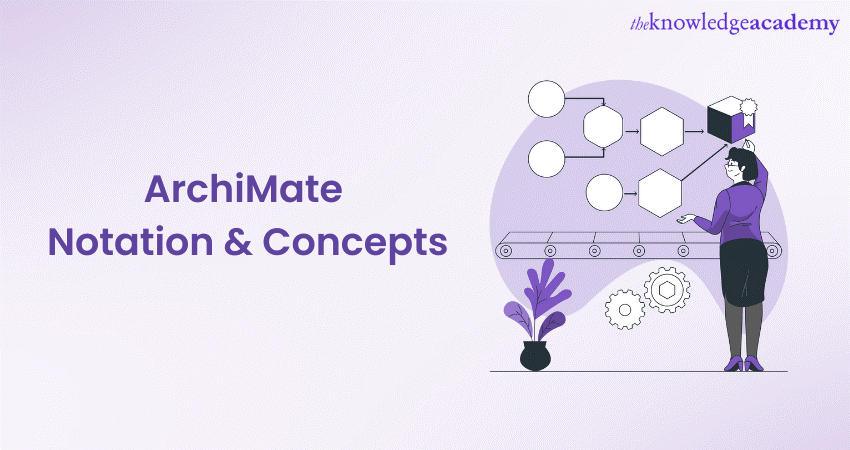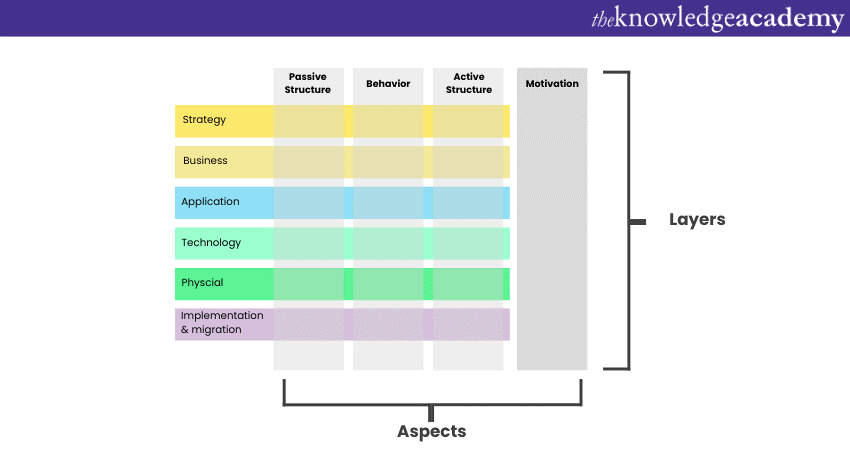We may not have the course you’re looking for. If you enquire or give us a call on +1 6474932992 and speak to our training experts, we may still be able to help with your training requirements.
We ensure quality, budget-alignment, and timely delivery by our expert instructors.

Organisations across the globe require a standardisation of processes and workflows. They’re quite crucial as they help maintain homogeneity across tools, technologies, etc. Enterprise Architectures creates a blueprint for all organisational processes. However, there are way too many modelling tools that can help you create an Enterprise Architecture. Choosing a viable one among many is an important process.
ArchiMate is a prominent and widely used Enterprise Architecture modelling tool that assists organisational development. This blog will focus on the intricacies of ArchiMate Notation; you’ll get to know its types, the concepts involved, and much more.
Table of Contents
1) What is ArchiMate?
2) What is an ArchiMate Notation?
a) Types of ArchiMate Notations
3) What concepts comprise ArchiMate?
4) Conclusion
What is ArchiMate?
ArchiMate is an Enterprise Architecture modelling language that helps with the graphical representation of processes and their relations. Using the ArchiMate Language and its visual framework, you can analyse, optimise, and add elements to complex systems. It is a cross-functional platform, as it is extensively used by both the IT and managerial (stakeholder) realms across various organisations.
When it comes to visual frameworks, an ArchiMate Notation effectively illustrates almost all processes and elements. Incorporating the Archimate Core Framework adds even more visual clarity and coherence to how structures are designed, while also enabling you to shift perspectives and make adjustments to enhance the workflow.
Having trouble adding more nuances to your Enterprise Architecture? Try this ArchiMate Training.
What is an ArchiMate Notation?
Since ArchiMate is extensively used for Enterprise Architecture creation, it becomes obvious to speculate its usage of graphical representation to some extent. In fact, it uses a lot of elements to represent processes. A Notation in ArchiMate usually refers to the set of symbols, colours, and shapes used to represent relationships, concepts, and elements. Different elements require different Notations for their representation. These Notations also help explain and represent the layers present in the Enterprise Architecture.
Types of ArchiMate Notations
There are a number of ArchiMate Notations that help define the different layers of an Enterprise Architecture. While there are three core layers that constitute key elements of an organisation’s structure, other layers can be added to the mix as well. These additional layers form a more detailed picture of the entire structure and help identify the pain points.
While an ArchiMate Notation can be used for a layer’s representation, it is imperative to understand what layers usually constitute architecture. Here's a list of the core layers:
1) Technology layer Notation: This layer constitutes the software and hardware in use and their intended layers and infrastructure. Here, different symbols are used to represent technology components such as systems, networks, and devices.
2) Application layer Notation: The application layer comprises software components and their interactions. Symbols in this layer can be used to represent application functions, application components, application services, and application interfaces.
3) Business layer Notation: As the name suggests, this layer caters to the processes, business goals, and services of the organisation. Symbols in this layer represent business processes, business actors, business roles, and business objects.
Additional layers can be listed in the following manner. Bear in mind that the aforementioned three layers are ever present in every Enterprise Architecture. Hence, they’ve been listed separately.
1) Motivation layer Notation: This layer caters to motivation-related concepts as they can influence architectural decisions. Symbols for this layer comprise a representation of goals, stakeholders, principles, and drivers. This Notation is often used to represent the alignment of architecture with strategic objectives.
2) Physical and logical Notation: This is actually a sub-layer of the technology layer and comprises Notations for physical components such as servers and hardware. It also comprises Notations for logical components such as software services and applications.
3) Composite structures Notation: The composite structures Notations are used to represent composite structures. Composite structures here refer to elements that can be present in a nested manner. This Notation allows architects to represent the constituents of elements if they’re made of more than one sub-element. It also helps establish relationships in a complex system.
4) Implementation and migration Notation: This Notation is used to represent migratory processes in an organisation. At times, organisations change their ways to implement new methodologies to certain processes. This can include migration from a specific technology, methodology, etc. Symbols here represent deliverables, work packages, and migration patterns/paths if done more than once.
Experience the way an enhanced ArchiMate works and dissects the inner workings of the better version with ArchiMate 3.1 Training Course: Level 1.

What concepts comprise ArchiMate?
Every element in ArchiMate is a Notation of a concept or a part of it. Just like every other organisational architecture tool, ArchiMate has its own fair share of concepts. These concepts define elements, processes, relationships, layers, and a lot more. The following list of concepts dictates how a structure works. These concepts are then represented through Notations comprising symbols, colours, and other pictorial elements.
1) Elements: Every organisation has a set of fixed elements that is identical across the industry. Nearly every organisation uses elements such as business elements, technology elements, and application elements. These elements form the three basic layers of Enterprise Architecture.
2) Relationships: Elements in Enterprise Architecture have relations with each other. Some relationships are straightforward, while some are complex. Relationships pertain to associations, compositions, dependencies, and other forms of connections that are established to achieve an objective. These relationships can be of a cross-functional nature as well.
3) Viewpoints: Viewpoints refer to different perspectives that can be used to view a set of elements or relationships.
4) Layers: As discussed above, layers constitute the workflow of the Enterprise Architecture while considering all aspects that define a business. For the most part, there are three main layers that form the core of any enterprise structure, they’re Business, Application, and Technology layers.
5) Principles and guidelines: Another useful concept that can be found in ArchiMate is the ability to define principles and guidelines. It ensures that the organisation stays on par with the latest guidelines and business objectives.
6) Dependence and flow: Since elements can be found in every stage/layer of the architecture, they can be associated with each other as well. ArchiMate Notation helps establish process flows and relationships between elements.
Conclusion
The latest iteration of ArchiMate Notation, the ArchiMate 3 Notation, has a list of updated features that can assist in establishing and correlating elements. This Enterprise Architecture modelling tool is not only robust but highly capable. The Notation roster is immense, and it can now be used to represent more complex and nuanced processes and elements. Adhering to the concepts listed above, Notations can not only help establish a complex process but can also help reduce costs and resources and plan effectively.
Engage in practical situations and come out on top with robust solutions with the ArchiMate 3.1 Training Course: Level 2
Upcoming Business Improvement Resources Batches & Dates
Date
 ArchiMate® 3 Training Course
ArchiMate® 3 Training Course
Thu 22nd May 2025
Thu 24th Jul 2025
Thu 25th Sep 2025
Thu 20th Nov 2025
Thu 11th Dec 2025






 Top Rated Course
Top Rated Course



 If you wish to make any changes to your course, please
If you wish to make any changes to your course, please


